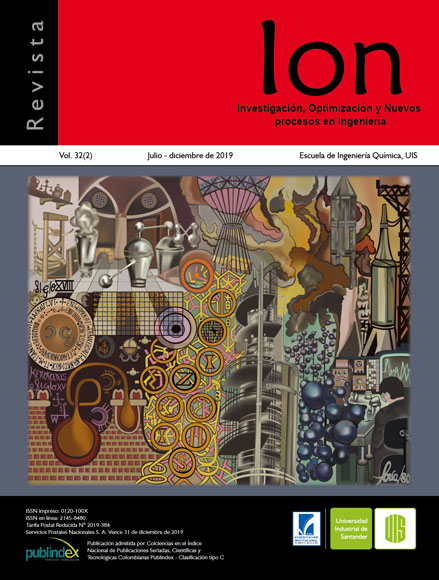Published 2019-12-17
Keywords
- Bio-flocculant, Okra, Turbidity removal, Mucilage, Okra powder, Water treatment.
How to Cite
Abstract
Mucilage and powder of okra were evaluated as bio-flocculant in water treatment using jar test. The agitations sets, okra preparation methods and the amount of coagulant/bio-flocculant were evaluated in the turbidity removal. The results showed that agitations set of 150 rpm and then 40 rpm were more effective for reducing turbidity. The results showed that when using 80 mg l-1 of coagulant was observed 39 % of turbidity removal and adding mucilage and powder of okra it was up to 76 % and 88 %, respectively. Therefore, all results showed that okra powder present better turbidity removal in water treatment. It can be prepared by simple methodology, and also allow the coagulant reduction in approximately 64 %. In okra powder were identified hydroxyl groups that serve as active sites for colloidal particles removal.
Downloads
References
[2] Freitas TKFS, Oliveira VM, De Souza MTF, Geraldino HCL, Almeida VC, Fávaro SL, Garcia JC. Optimization of coagulation-flocculation process for treatment of industrial textile wastewater using okra (A. esculentus) mucilage as natural coagulant. Industrial Crops and Products Journal. 2015;76:538-44.
[3] Jarvis P, Jefferson B, Gregory JOHN, Parsons SA. A review of floc strength and breakage. Water research. 2005;39:3121-37.
[4] Choy SY, Prasad KMN, Wu TY, Ramanan RN. A review on common vegetables and legumes as promising plant-based natural coagulants in water clarification. International Journal of Environmental Science and Technology. 2015;12:367-90.
[5] Lee CS, Chong MF, Robinson J, Binner E. Optimisation of extraction and sludge dewatering efficiencies of bio-flocculants extracted from Abelmoschus esculentus(Okra). Journal of Environmental Management. 2015;157:320-5.
[6] Anastasakis K, Kalderis D, Diamadopoulos E. Flocculation behavior of mallow and okra mucilage in treating wastewater. Desalination Journal. 2009;249:786-91.
[7] Bolto B, Gregory J. Organic polyelectrolytes in water treatment. Water Research Journal. 2007;41:2301–24.
[8] Kumar DS, Tony DE, Kumar AP, Kumar KA, Srinivasa DB, Nadendla R. A review on Abelmoschus esculentus (Okra). Int Res J Pharm App Sci. 2013;3:129-32.
[9] Finger FL, Della-Justina ME, Casali VWD, Puiatti M. Temperature and modified atmosphere affect the quality of okra. Scientia Agricola. 2008;65:360-4.
[10] Kitinoja L, AlHassan HY. Identification of appropriate postharvest technologies for small scale horticultural farmers and marketers in sub-saharan Africa and south Asia - part 1 postharvest losses and quality assessments. Acta Hortic. 2012;934:31-40.
[11] Okolo BI, Menkiti MC, Nnaji PC, Onukwuli OD, Agu CC. The Performance of Okra seed (Hibiscus esculentus L.) Extract in Removal of Suspended Particles from Brewery Effluent by Coag-Flocculation Process. British Journal of Applied Science & Technology.2014;34:4791-806.
[12] Ding Y, Chen J, Gong W. Synthesis and flocculation characteristics of cationic modified corncob: a novel polymeric flocculant. Agricultural Sciences Journal. 2013;4:23–8.
[13] Jones AN, Bridgeman J. Investigating the characteristic strength of flocs formed from crude and purified Hibiscus extracts in water treatment. Water research. 2016;103:21-9.
[14] Thakur SS, Choubey S. Assessment of coagulation efficiency of Moringa oleifera and Okra for treatment of turbid water. Archives of Applied Science Research. 2014;6:24-30.
[15] Aziz HA, Alias S, Adlan MN, Asaari AH, Zahari MS. Colour removal from landfill leachate by coagulation and flocculation processes. Bioresource technology. 2007;98:218-20.
[16] Jesus E, Cruz PV, Pacífico JA, Silva AS. Removal of turbidity, suspended solids and ions of Fe from aqueous solution using okra powder by coagulation-flocculation process. American journal of water resources. 2013;1:20-4.
[17] Palei NN, Mamidi SK, Rajangam J. Formulation and evaluation of lamivudine sustained release tablet using okra mucilage. J App Pharm Sci. 2016;6:069-75.
[18] Jahan MS, Alam D, Rahman MM, Quaiyyum MA. Isolation and characterization of lignin from okra (Abelmoschus esculentus) fibre and stick. Bangladesh Journal of Scientific and Industrial Research. 2015;50:257-62.
[19] De Rosa IM, Kenny JM, Maniruzzaman M, Moniruzzaman M, Monti M, Puglia D, Santulli C, Sarasini F. Effect of chemical treatments on the mechanical and thermal behaviour of okra (Abelmoschus esculentus) fibres. Composites Science and Technology. 2011;71:246-54.

